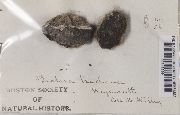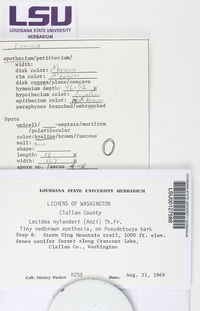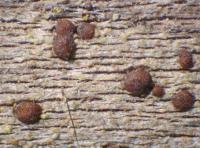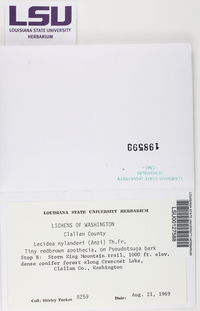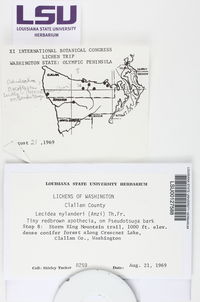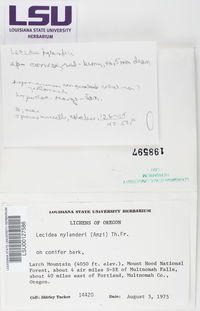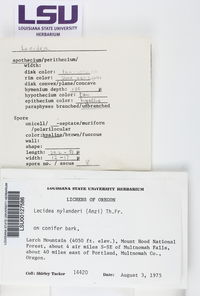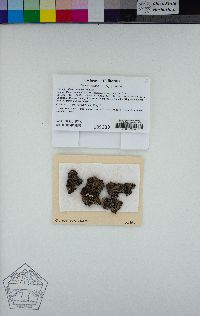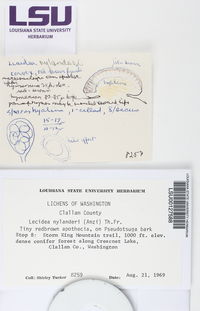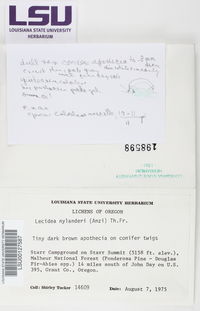
Consortium of Lichen Herbaria
- building a Global Consortium of Bryophytes and Lichens as keystones of cryptobiotic communities -
- Home
- Search
- Images
- Species Checklists
- US States: O-Z >
- US National Parks
- Central America
- South America
- US National Parks
- Southern Subpolar Region
|
|
|
|
Family: Ramalinaceae
[Biatora breadalbanensis (Stirt.) Walt. Watson, moreBiatora tornoënsis (Nyl.) Th. Fr., Lecidea breadalbanensis Stirt., Lecidea tornoënsis Nyl., Mycoblastus tornoensis (Nyl.) R. Anderson] |
Nash, T.H., Ryan, B.D., Gries, C., Bungartz, F., (eds.) 2004. Lichen Flora of the Greater Sonoran Desert Region. Vol 2. Thallus: crustose, areolate, sometimes becoming continuous, indeterminate to deteminate, esorediate, in irregularly rounded patches up to 5 cm or more wide prothallus: not evident to distinct, brown, composed of ramifying hyphae, at the thallus margin radiating, and sometimes forming a distinct fibrous zone areoles: adnate, sometimes effigurate, rounded to irregular, flat to convex, scattered at first and 0.20-0.25 mm in diam., later becoming contiguous and often continuous, not stratified surface: pale green to pale brown, dull to glossy Apothecia: rounded, often becoming tuberculate, 0.4-1(-1.5) mm in diam. disc: chestnut brown to dark red-brown, sometimes paler along the margin (exciple), glossy to dull, flat to convex, often a mixture (on the same thallus) of rather flat to convex ones, sometimes flat along the edge and becoming slightly convex towards the center, epruinose margin: usually lacking from the beginning exciple: usually very thin and reflexed, hyaline to brown, similar in structure to the hamathecium epihymenium: brown (not characterized by Meyer and Printzen 2000), without crystals, pigment sometimes streaking into hymenium, 10-20 µm thick hymenium: hyaline to pale brown, with or without oil drops, 60-95 µm tall; paraphyes: moderately to strongly branched and anastomosing, basally colorless, 1-1.5 µm wide, apically to 2.5-3(-5) µm wide, with a distinct dark brown pigment caps subhymenium and hypothecium: hyaline or patchy brown, together 60-185 µm thick asci: broadly ellipsoid to clavate, 48-80 x 22-48 µm, 8-spored ascospores: hyaline, simple, ellipsoid to broadly ellipsoid, (11-)16.5-20.2(-28) x (10-)11-12.7(16) µm; wall: composed of several layers, (1-)1.5-2.5(-3) µm wide Pycnidia: +globose, semi-immersed, c. 130 µm in diam., with a brown wall; conidiogenous hyphae of type V (Vobis 1980) conidia: bacilliform, 6-7 x c. 1 µm. Spot tests: all negative Secondary metabolites: none detected. Substrate and ecology: on wood and bark of conifers (mainly) in subalpine forests World distribution: circumboreal, Eurasia and North America Sonoran distribution: Arizona, 2800-3400 m. Notes: Many specimens of J. tornoënsis from North America have relatively large and flattened apothecia similar to those of J. subaurifera Muhr & Tönsberg, but they are typically small (0.3-0.5(-1 mm)) and strongly convex to globose in J. tornoënsis. At present it is undecided whether they belong to separate species. Specimens from Arizona are somewhat intermediate between the extremes. |
|
|
|
Powered by Symbiota



